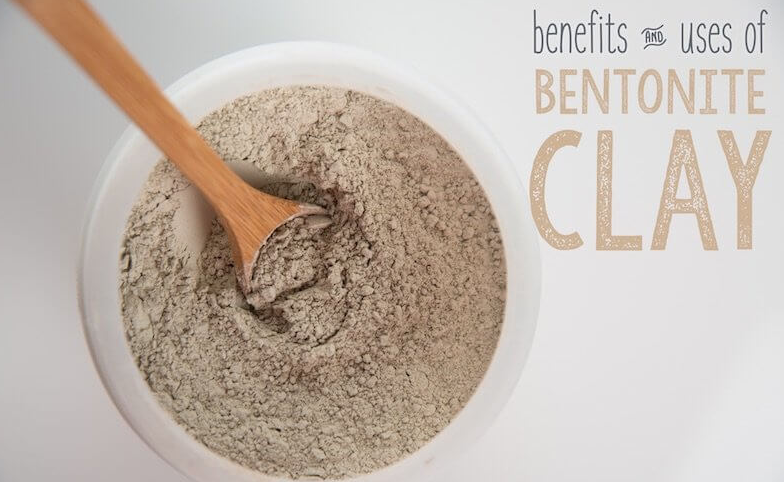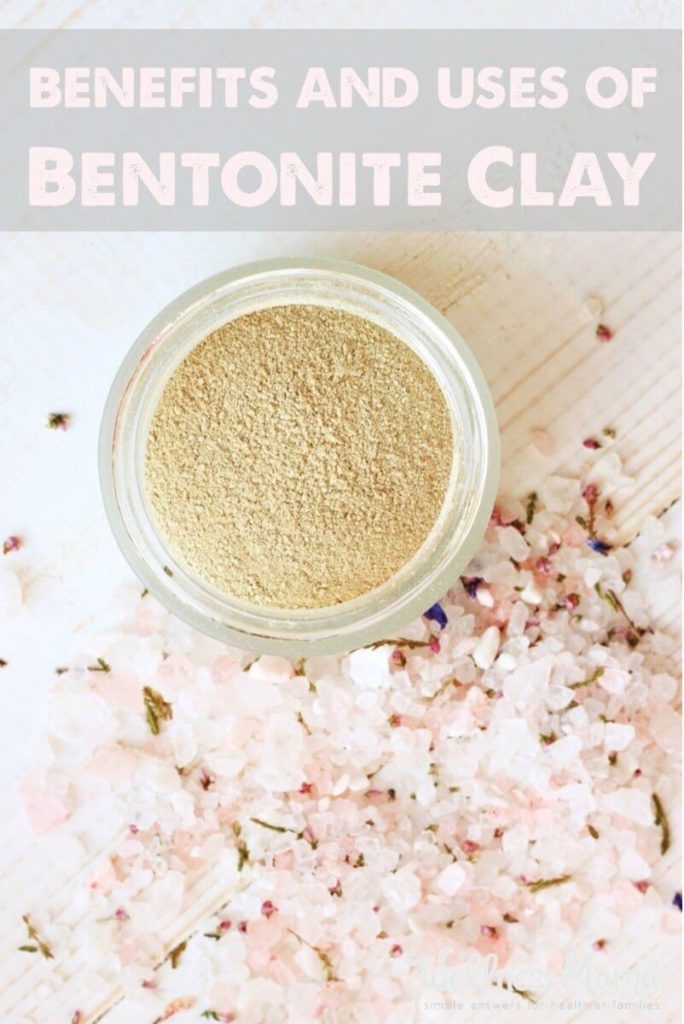Benefits of Bentonite Clay ( And How to Use It).

Benefits of Bentonite Clay ( How to Use It? )
Katie Wells 634 Comments Updated: January 23, 2019.
In modern times we have largely forgotten that cultures throughout the ages used bentonite clay and other healing clays for their nutrients and to help rid the body of toxins.
If we take a cue from nature, many animals will instinctively turn to eating dirt and clay to help remove poisons from their systems or during times of illness or distress.
More recently, healing clays like bentonite clay have once again gained popularity for internal and external detoxification, and with good reason.
What Is Bentonite Clay?
Bentonite clay consists of aged volcanic ash also known as “Montmorillonite.” The name comes from the largest known deposit of bentonite clay located in Fort Benton, Montana.
It is an odorless grey/cream color with an almost soft, very fine consistency. Unlike some other clays, it doesn’t stain and is easy to work with in beauty and natural remedy recipes.
Healing clays like bentonite have a high concentration of minerals including silica, calcium, magnesium, sodium, iron, and potassium. It also absorbs and removes toxins, heavy metals, impurities, and chemicals.
Because of this, bentonite clay is a common ingredient in detox and cleansing products. Common external uses include poultices, mud packs, detox baths, and skin care recipes.
Some (including myself) even use it internally. It has an alkalizing effect on the body and when taken correctly, it can help balance gut bacteria.
Bentonite Clay Benefits & How It Works
Bentonite clay is a unique clay due to its ability to produce an “electrical charge” when hydrated. Upon contact with fluid its electrical components change, carrying a strong negative charge which bonds to the positive charge in many toxins.
When it comes in contact with a toxin, chemical, or heavy metal, the clay will absorb the toxin and release its minerals for the body to use. Bentonite also helps get oxygen to cells as it pulls excess hydrogen and allows the cells to replace it with oxygen instead.
Personally, I’ve seen people benefit from taking bentonite clay to help with:
- digestive disturbances like acid reflux, constipation, bloating, gas, etc. (Kaolin clay was common ingredient in medicines like Maalox and Rolaids for years.)
- helping with skin and allergy issues
- providing minerals for the body
- recovering from vomiting and diarrhea
- detoxification
- oral health preparations
- externally for all types of skin problems and to speed healing
Even Dr. Weston A Price, in his book Nutrition and Physical Degeneration reported that several native cultures including those in the Andes, Central Africa, and Australia consumed clays in various ways. Commonly they would carry balls of the dried clay in their bags and dissolve a small amount of the clay in water with meals to prevent poisoning from any toxins present.
In a study from Arizona State University, bentonite clay was found to be highly effective at killing MRSA as well as Salmonella, E. Coli and others. What is promising as research continues in this area is that depending on the method in which the clay kills the infection, it may not be possible for the MRSA or other bacteria to develop a resistance to it as it does with antibiotics.
How to Use Bentonite Clay
Bentonite (and other clays) are staples in my homemade herbal cabinet and medicine chest. I’ve used them internally and externally for various issues on myself, my husband my kids.
- On the Skin: Externally, I apply a paste of bentonite clay and water on any skin irritation like blemishes, insect bites, cuts, skin itching, or burns. I leave it on until it dries and wash off. This is said to be especially calming to skin itching from eczema, psoriasis, chickenpox, etc.
- Armpit Detox: I use a mix of bentonite clay and apple cider vinegar to detox my armpits.
- Skin Poultice for Bug Bites/Burns/Cuts/Stings: For more severe issues, I create a poultice by putting a thick layer of clay on the skin and applying a wet gauze or cloth over it. I wrap the area and leave the poultice on, changing every 2 hours. I’ve even applied this treatment on poison ivy.
- Face Mask: Many beauty products use bentonite clay for its ability to bind with and remove toxins and impurities. For smooth and healthy skin, I make a bentonite clay mask simply by mixing a paste of bentonite and water. I leave on for 20 minutes and wash off with warm water. I typically do this once or twice a week. Bentonite clay powder mixed with apple cider vinegar also makes an excellent and balancing face mask.
- Detox Bath: I sometimes add about 1/4 cup of bentonite clay to bath water for a relaxing detox bath that softens skin.
- For Oral Health: Because of its excellent ability to bind to heavy metals and toxins as well as to provide minerals, I use bentonite clay in my Remineralizing Tooth Powder Recipe. It can even be used alone for brushing and is tasteless and relatively textureless.
- As an Oral Rinse to Whiten and Remineralize Teeth: Besides the use in my tooth powder, I use bentonite mixed with water as an alkalizing and toxin-removing mouth rinse. I mix 1/2 teaspoon of clay in 1/4 cup water in a small jar with a plastic lid and shake well. Then, I rinse with the water for 1-2 minutes and repeat until I’ve used it all.
- For Mastitis: I’ve created a poultice or mask of bentonite clay and water and applied externally to the area. I repeat as needed every hour until the infection is gone. I also take internally during infection along with vitamin C and fish oil capsules.
- For Baby Powder: Plain bentonite clay makes a very soothing baby powder for use when there is infection or redness. It can also be made into a clay “mask” to help speed recovery in this area.
- For Digestive Problems or Morning Sickness: I took 1/2 tsp of bentonite clay in water during early pregnancy to ward off morning sickness. It helped with the nausea and helped me feel better. I checked with my doc/midwife first and was told this was fine. Check with your doctor or medical professional before using during pregnancy.
- For Internal Cleansing: I drink 1/2 to 1 teaspoon most days in a cup of water. I combine in a glass jar with a plastic lid and shake until well incorporated. This has helped improve my digestion and also seems to give me more energy.
- For Pets: For pets that are sick, vomiting or showing signs of illness, you can add bentonite to their water or mix and give orally with a dropper or syringe without the needle. I have seen several cases where this helped pets recover quickly from what could otherwise have been serious illnesses.
- Other Uses: Though I have not needed to use for these reasons personally, I have read cases of bentonite and other healing clays being used internally to help reduce radiation exposure, in alternative cancer treatments, and in MRSA infections. It is also said to greatly help in parasite removal, though I have not tried this personally.
Best Bentonite Clay & Precautions
- Do not let healing clays like bentonite come in to contact with anything metal, as this will reduce the effectiveness. I mix with water in a glass jar with a plastic lid by shaking well or using a plastic whisk.
- If you take it internally, do not take within an hour of food for best results and do not take within 2 hours of medications or supplements as it might reduce their effectiveness. Check with your doctor before using if you have any medical condition.
- Because bentonite clays can contain lead (read my full thoughts on that here), it is important to get it from a reliable quality source.

